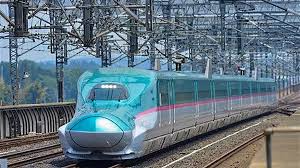What is the current status of Mumbai-Ahmedabad Bullet train project?

India’s first high-speed rail line, the ambitious Mumbai–Ahmedabad bullet train project, is gradually transforming from blueprint to reality. Touted as a milestone in India’s infrastructure growth, this 508-kilometre corridor aims to slash travel time between Mumbai and Ahmedabad from over 7 hours to just 2 hours. The project, backed by Japanese Shinkansen technology and funded largely by Japan International Cooperation Agency (JICA), is making visible progress despite earlier delays.
So, what’s the latest on this landmark venture? Here’s a comprehensive look at the current status of the Mumbai–Ahmedabad bullet train as of July 2025.
🚧 Construction Progress: Civil Work Gains Pace
The National High-Speed Rail Corporation Limited (NHSRCL), which oversees the project, has accelerated civil construction across both Gujarat and Maharashtra.
- Viaducts: As of mid-2025, over 310 km of viaducts (elevated bridges that carry the track) have been completed. Full Span Launching Method (FSLM) is being used to speed up construction and minimize delays, especially in urban and coastal areas.
- Bridges and Foundations: Of the 24 river bridges needed, 15 have been completed, with work on four more nearing completion. Additionally, more than 380 km of pier and foundation work has been done across the alignment.
- Underground Tunneling: One of the project’s most complex features is a 21-km underground tunnel, including a 7-km stretch under the Thane Creek. In a major milestone, a 2.7 km tunnel section has now been successfully bored. Dual tunneling methods—Tunnel Boring Machine (TBM) and New Austrian Tunneling Method (NATM)—are being used for this segment.
🏙️ Station Development: Modern Hubs Taking Shape
The bullet train project includes 12 high-speed stations, designed with modern amenities and intermodal connectivity to buses, autos, and metro lines.
- Gujarat Progress: Stations in Surat, Bilimora, Bharuch, and Vadodara are nearly finished. Surat’s station is the most advanced and expected to play a central role in the pilot phase.
- BKC Station in Mumbai: The underground Bandra Kurla Complex (BKC) station is about 75% complete. Located in one of Mumbai’s busiest business districts, this station will be India’s first underground bullet train terminal.
- Depots: Major maintenance depots are under construction in Sabarmati (Gujarat) and Thane (Maharashtra). Sabarmati will also host an integrated terminal combining high-speed rail with metro and city rail services.
⚠️ Challenges: Delays & Diplomatic Roadblocks
Despite considerable progress, the project has not been without setbacks.
- Tunnel Boring Machine (TBM) Delays: Three essential TBMs manufactured in China remain stuck at a port due to geopolitical and customs complications. This delay threatens the timeline for completing the Mumbai underground tunnel section.
- Land Acquisition in Maharashtra: While land acquisition in Gujarat is nearly 100% complete, Maharashtra faced political and local resistance. As of 2025, over 90% of the land has been acquired, unlocking progress in sensitive urban zones like BKC and Thane.
- Technical Complexities: Navigating through rocky terrain, urban congestion, and environmentally sensitive zones has made certain segments, especially in Mumbai and Thane, more time-consuming.
🛤️ Rolling Stock: The Shinkansen Experience Awaits
India is set to debut the Japanese E5 Series Shinkansen trains for its initial bullet train runs. These trains can reach speeds of 320 km/h, offering a fast, smooth, and silent ride.
- Trial Runs: Early trials will begin in Gujarat by 2026, primarily between Surat and Bilimora, as that section nears completion.
- Future Models: Japan’s next-gen E10 Shinkansen series, expected to debut in the 2030s, is also being considered for long-term deployment on this corridor.
🕒 Project Timeline: What to Expect?
- 2026–2027: First test runs in Gujarat, followed by limited operations between Surat and Bilimora.
- 2028–2029: Targeted full operation from Mumbai to Ahmedabad, contingent on tunnel completion and TBM delivery.
- 2030: Conservative deadline for total project rollout with advanced trains and full-speed capability.
Despite the logistical challenges, NHSRCL has reiterated that no major timeline shift is currently being considered. However, experts believe the 2030 target is more realistic, given the scale and complexity of the project.
🌱 Environmental and Economic Impact
The bullet train project is expected to significantly reduce travel emissions and road congestion between Mumbai and Ahmedabad. Over 1.6 million people are estimated to use the corridor annually, helping decongest highways and short-haul flights.
It is also projected to boost job creation, improve regional connectivity, and serve as a model for future high-speed rail networks in India. Moreover, the introduction of advanced Japanese railway technology is expected to improve local rail engineering capabilities.
✅ Conclusion: On Track, But Not Without Hurdles
The Mumbai–Ahmedabad bullet train is India’s first foray into high-speed rail, and while it has faced its share of challenges—ranging from land disputes to machinery delays—it remains a symbol of India’s future-focused infrastructure push.
With over 60% of civil work completed, several major stations near completion, and Gujarat ready for trial runs, the dream of a lightning-fast rail journey between two of India’s busiest cities is closer than ever.
As India builds its bullet train legacy, the world watches with anticipation.






